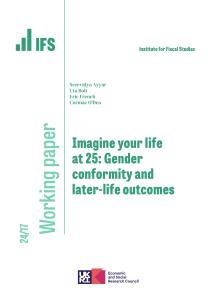I am not normal. Just ask my kids. I’m not referring to my odd mannerisms, terrible driving or practical incompetence, rather to my experience of the economy, my education and my earnings.
Ministers and members of parliament are not normal, either. They get to see more of life through their constituency surgeries than most of us, even if some of them seem to forget it all too easily. I see it differently, in the data that my colleagues and I work with all the time. I am in the unusual position of having rather a good grasp on what the income distribution looks like. I know where I sit in it. And in the distributions of health, wealth and education.
Even so, I am sometimes surprised at just how odd I am. Or was. You may have noticed that one of the ideas being put about by government to ease the cost-of-living crisis is to reduce the cost of childcare, perhaps by loosening the constraints on how many young children any one carer can look after in a nursery setting. Now it’s a very long time since my children were in nursery — the youngest are now at university — but I clearly remember the staggering amounts we used to pay. Childcare is expensive and surely it would help millions of families with young children to reduce the cost.
Not so much, it turns out. More than half of families with a pre-school-age child pay precisely nothing for childcare. That’s partly because some, especially with very young children, don’t use childcare at all. More important is that a lot of “free” childcare is provided by doting, or perhaps put-upon, grandparents and other relatives.
Among older pre-schoolers, the vast majority, more than eight in ten, do use some formal childcare. Even so, two thirds pay less than £20 per week for it. That’s because there is already a significant free entitlement of at least 15 hours a week for all three and four-year-olds and 30 hours where both parents are working — sadly, not something that existed in anything like such generous form when my sons were small. Some things do improve.
All of which suggests that cutting the cost of childcare would make no difference to the vast majority of families with young children. It could help some to gain access to more childcare, if costs are putting them off at the moment, but it is notable that half the parents of three and four-year-olds do not even use their present full free entitlement.
Plenty of families do spend an awful lot on childcare, but they are in a relatively small minority. At the top end, one in ten users of formal childcare in London spend more than £350 a week. Hardly anyone in any other region of England pays that much. Such figures may be more in the minds of policymakers than perhaps they should be. Frankly, they are more in my mind than they should be because that’s closer to my experience and the experience of many of my friends and colleagues.
That’s where the biggest numbers are, but this is not simply a metropolitan elite issue. A fifth of middle-earners using formal childcare report finding it difficult to manage the cost. Among all families with pre-school children, one in ten have reported difficulty meeting costs. And that was last year.
There is a problem, and it is a growing one. In the decade before the present inflationary spurt, the cost of a part-time nursery place for the youngest children rose more than twice as quickly as overall prices. The fact that we insist on more carers per child for the under-twos than do most other countries pushes up the costs. Our rather convoluted system of subsidies, not at all well targeted towards those on the lowest incomes, doesn’t help.
There is one element of government support, supposedly one of its central planks, that seems to be especially ineffective. That is tax-free childcare. It’s ineffective because most families have never even heard of it, and that includes half of those who would be entitled to it. Even some of those who are aware of it are put off from claiming it by the hassle and complexity. Take-up has been so poor that it has ended up costing just a quarter of what was projected. In the four years since it was introduced, it has cost more than £2 billion less than intended.
There’s another reminder for policymakers — and for me. Things that look great on paper, that work well in theory, won’t necessarily cut through to a general public who have got far better things to do than keep on top of all the latest policy twists and turns.
If the government wants to help with the cost of living, there will be some families who would benefit from cheaper childcare. But not a huge number of them, not very soon and not on the whole those on the lowest incomes. In any case, childcare is, or should be, about much more than merely keeping the kids out from under the parents’ feet. Policy should focus on making sure that it is as high-quality as possible and on ensuring that those children likely to benefit most do so. The present system already offers free care to the 40 per cent most disadvantaged two-year-olds because they are the biggest potential beneficiaries. Two thirds don’t take up their full entitlement.
There is much to do to get childcare policy right, but let’s not mix it up with sorting out the present cost-of-living crisis. The first step to achieving that was, is and will continue to be increasing benefits in line with inflation. That would provide immediate help to millions of poor families with children.
This article was first published in The Times and is reproduced here with kind permission.









